Metro-Goldwyn-Mayer (MGM or Metro) is one of the world's oldest film studios. MGM was founded in 1924 when the entertainment entrepreneur Marcus Loew gained control of Metro Pictures, Goldwyn Pictures, and Louis B. Mayer Pictures. From the end of the silent film era through the late 1950s, Metro-Goldwyn-Mayer was the dominant Hollywood studio. MGM had 'More Stars Than There Are in Heaven' including Greta Garbo, John Gilbert, Lon Chaney, Norma Shearer, Ethel, Lionel, and John Barrymore, Joan Crawford, Jeanette MacDonald, Clark Gable, Jean Harlow, William Powell, Myrna Loy, Katharine Hepburn, Spencer Tracy, Judy Garland, Mickey Rooney, Elizabeth Taylor, Gene Kelly, and Greer Garson. In 1971, it was announced that MGM was to merge with 20th Century Fox, but the plan never came to fruition. Over the next 39 years, the studio was bought and sold at various points in its history.

Jean Harlow. Spanish collectors card by J.G. Viladot, Barcelona. Photo: Metro-Goldwyn Mayer.

Judy Garland. Belgian postcard by S.A. Victoria, Brussels, no. 639. Photo: Metro-Goldwyn-Mayer.
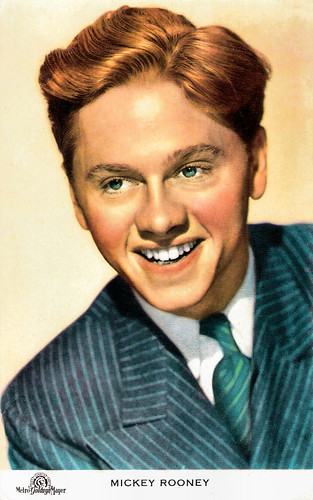
Mickey Rooney. Belgian postcard by Victoria, Brussels, no. 639. Photo: Metro-Goldwyn-Mayer.
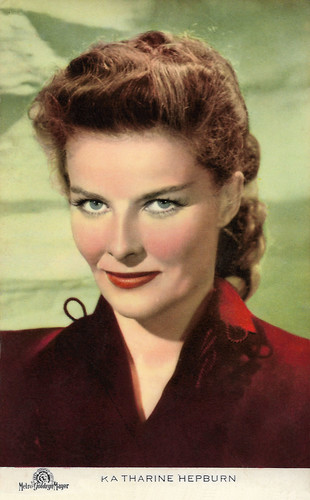
Katharine Hepburn. Belgian postcard by N.V. Victoria, Brussels, no. 12. Photo: Metro-Goldwyn-Mayer.
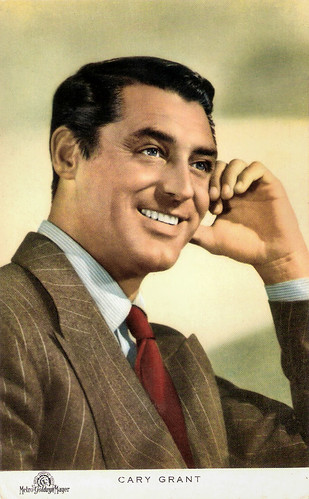
Cary Grant. Belgian postcard by N.V. Victoria, Brussels, no. 639. Photo: Metro-Goldwyn-Mayer.
In 1924, film theatre magnate Marcus Loew had a problem. He had bought Metro Pictures Corporation in 1919 for a steady supply of films for his large Loew's Theatres chain. With Loew's lackluster assortment of Metro films, Loew purchased Goldwyn Pictures in 1924 to improve the quality. However, these purchases created a need for someone to oversee his new Hollywood operations, since longtime assistant Nicholas Schenck was needed in New York headquarters to oversee the 150 theatres.
Approached by Louis B. Mayer, Loew addressed the situation by buying Louis B. Mayer Pictures in 1924. Mayer became head of the renamed Metro-Goldwyn-Mayer, with Irving Thalberg as head of production. Mayer would remain executive head of the studio for 25 years. The 24-year-old 'boy wonder' Thalberg became the creative head of production with the authority to reedit any MGM film, along with the no-nonsense Harry Rapf, as production supervisor. The new studio launched with tremendous success when their first silent film, He Who Gets Slapped (Victor Sjöström, 1924) starring Lon Chaney, became a critical and commercial hit.
MGM's classic logo, a roaring lion encircled in a banner with the words Ars Gratia Artis (Art for Art's Sake), was already created in 1916 for the Goldwyn Pictures Corporation by ad executive Howard Dietz. The first lion, called Slats, was used for the original Goldwyn Pictures design and for the first MGM version. He didn’t actually roar, preferring to people watch. The lion gave an audible roar on 31 July 1928 for the premiere of the film White Shadows in the South Seas. The roar was heard via a gramophone record.
From the outset, MGM tapped into the audience's need for glamour and sophistication. Having inherited few big names from their predecessor companies, Mayer and Thalberg began at once to create and publicise a host of new stars, among them were Greta Garbo, John Gilbert, William Haines, Joan Crawford, and Norma Shearer. Thalberg and Shearer soon became husband and wife.
Established names like 'the man of a thousand faces' Lon Chaney, William Powell, Buster Keaton, Marion Davies, Ramon Novarro and Wallace Beery were hired from other studios. They also hired top directors such as King Vidor, Clarence Brown, Erich von Stroheim, Tod Browning, and Victor Sjöström a.k.a. Victor Seastrom.
In its first two years, MGM produced more than 100 feature films. In 1925, MGM released the extravagant and successful Ben-Hur (Fred Niblo, 1925) featuring Ramon Novarro, taking a $4.7 million profit that year, its first full year. Soon followed two other hits, The Big Parade (King Vidor, 1925) starring John Gilbert, and Flesh and the Devil (Clarence Brown, 1926) with Gilbert and Greta Garbo. Also in 1925, MGM, Paramount and Ufa formed a joint German distributor, Parufamet.
MGM was one of the first studios to experiment with filming in Technicolor. Using the two-color Technicolor process then available, MGM filmed portions of The Uninvited Guest (Ralph Ince, 1924), The Big Parade (King Vidor, 1925), and Ben-Hur (Fred Niblo, 1925), among others, in the process. MGM released The Viking (Roy William Neill, 1928), the first complete Technicolor feature with a synchronised score and sound effects, but no spoken dialogue.
Marcus Loew died in 1927, and control of Loew's passed to Nicholas Schenck. In 1929, William Fox of Fox Film Corporation bought the Loew family's holdings with Schenck's assent. Mayer and Thalberg disagreed with the decision. Mayer was active in the California Republican Party and used his political connections to persuade the Justice Department to delay final approval of the deal on antitrust grounds.
During this time, in the summer of 1929, Fox was badly hurt in an automobile accident. By the time he recovered, the stock market crash in the fall of 1929 had nearly wiped Fox out and ended any chance of the Loew's merger going through. Schenck and Mayer had never gotten along (Mayer reportedly referred to his boss as Mr. Skunk), and the abortive Fox merger increased the animosity between the two men.

German postcard by Ross Verlag, no. 73/4. Photo: Parufamet / Metro-Goldwyn-Mayer. Ramon Novarro (or his double?) leading the chariot in Ben-Hur (Fred Niblo, 1925).

French postcard by Editions Cinémagazine, no. 393. Photo: MGM. John Gilbert in The Big Parade (King Vidor, 1925).

German postcard by Ross Verlag, no. 1886/1, 1927-1928. Photo: Clarence Sinclair Bull / Metro-Goldwyn-Mayer. Greta Garbo and John Gilbert in Flesh and the Devil (Clarence Brown, 1926).

German postcard by Ross Verlag, no. 3530/1, 1928-1929. Photo: Metro-Goldwyn Mayer. Jackie Coogan in Buttons (George W. Hill, 1927).
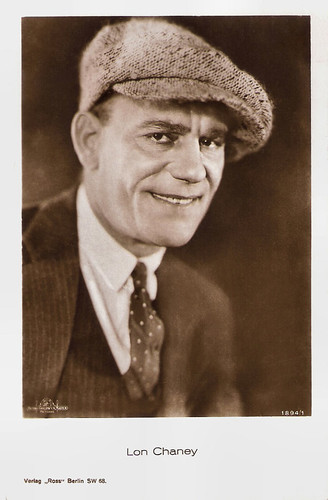
Lon Chaney. German postcard by Ross Verlag, no. 1894/1, 1927-1928. Photo: MGM / FaNuMet.
MGM was the very last studio to convert to sound film with their first full-fledged 'talkie', the musical The Broadway Melody (Harry Beaumont, 1929). However, it was both a box-office success and won the Academy Award as Best Picture of the Year. MGM had moved slowly and reluctantly into the sound era, releasing features like White Shadows in the South Seas (W.S. Van Dyke, 1928) with music and sound effects, and Alias Jimmy Valentine (Jack Conway, 1928) featuring William Haines, with limited dialogue sequences. The arrival of talking pictures gave opportunities to new stars, many of whom would carry MGM through the 1930s: Clark Gable, Jean Harlow, Robert Montgomery, Spencer Tracy, Myrna Loy, Jeanette MacDonald, and Nelson Eddy among them.
MGM's first all-color, 'all-talking' sound feature with dialogue was the musical The Rogue Song (Lionel Barrymore, 1930). MGM included a sequence made in Technicolor's superior new three-color process, a musical number in the otherwise black-and-white The Cat and the Fiddle (William K. Howard, 1934), starring Jeanette MacDonald and Ramon Novarro. The studio then produced a number of three-color short subjects including the musical La Fiesta de Santa Barbara (1935). Their first complete feature in the process was Sweethearts (W.S. Van Dyke, 1938) with Jeanette MacDonald and Nelson Eddy, the earlier of the popular singing team's two films in colour. From then on, MGM regularly produced several films a year in Technicolor with Northwest Passage (King Vidor, 1940) being one of the most notable.
Grand Hotel (Edmund Goulding, 1932) became the first film to feature an 'all-star' cast for the studio with such stars as John Barrymore, Joan Crawford, Greta Garbo, Wallace Beery, and Lionel Barrymore all gathered together. Other popular films of the early 1930s included Anna Christie (Clarence Brown, 1930), The Divorcee (Robert Z. Leonard, 1930) starring Norma Shearer, Trader Horn (W.S. Van Dyke, 1931) with Harry Carey, Private Lives (Sidney Franklin, 1931), Dinner at Eight (George Cukor, 1933), and A Free Soul (Clarence Brown, 1931), starring Shearer and one of MGM's most appealing new leading men, Clark Gable.
In addition to a large short-subjects program of its own, MGM also released the shorts and features produced by Hal Roach Studios, including comedy shorts starring Laurel and Hardy, Our Gang and Charley Chase. MGM's distribution deal with Roach lasted from 1927 to 1938, and MGM benefited in particular from the success of the popular Laurel and Hardy films. In 1938, MGM purchased the rights to the Our Gang series and moved the production in-house, continuing production of the successful series of children's comedies until 1944. From 1929 to 1931, MGM produced a series of comedy shorts called All Barkie Dogville Comedies, in which trained dogs were dressed up to parody contemporary films and were voiced by actors. One of the shorts, The Dogway Melody (Zion Myers, Jules White, 1930), spoofed MGM's hit musical The Broadway Melody (1929).
MGM entered the music industry by purchasing the 'Big Three' starting with Miller Music Publishing Co. in 1934 then Robbins Music Corporation. In 1935, MGM acquired a controlling interest in the capital stock of Leo Feist, Inc., the last of the 'Big Three'. During the first musical craze of 1928-1930, a custom MGM label was created by Columbia using tunes from MGM productions that were recorded by Columbia.
MGM produced approximately 50 pictures a year, though it never met its goal of releasing a new motion picture each and every week. Loew's 153 theatres were mostly located in New York, the Northeast, and Deep South. Gone with the Wind (Victor Fleming, 1939) had its world premiere at Loew's Grand Theatre in Atlanta, Georgia. A fine reputation was gained for lavish productions that were sophisticated and polished to cater to an urban audience. Still, as the Great Depression deepened, MGM began to economise by 'recycling' existing sets, costumes, and furnishings from yesteryear projects. This recycling practice never let up once started.
In addition, MGM saved money because it was the only one of the big five studios that did not own an off-site movie ranch. Until the mid-1950s, MGM could make a claim its rivals could not: it never lost money, although it did have an occasional disaster like Parnell (John M. Stahl, 1937), Clark Gable's biggest flop. It was the only Hollywood studio that continued to pay dividends during the 1930s.
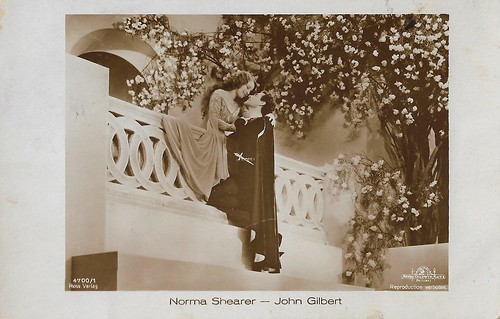
German postcard by Ross Verlag, no. 4700/1. Photo: Metro-Goldwyn-Mayer. Norma Shearer as Juliet and John Gilbert as Romeo in the early sound film The Hollywood Revue of 1929 (Charles Reisner, 1929), shot as a series of variety acts. In the film, this sequence was shot in two-color Technicolor.

German postcard by Ross Verlag, no. 7244/1, 1932-1933, distributed in Italy by Casa Editrice Ballerini & Fratini, Firenze. Photo: Metro-Goldwyn-Mayer. Jean Hersholt in Grand Hotel (Edmund Goulding, 1932).
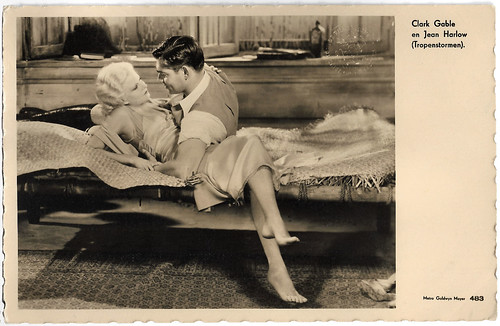
Dutch postcard, no. 483. Photo: M.G.M. Jean Harlow and Clark Gable in Red Dust (Victor Fleming, 1932). Sent by mail in 1935.

Dutch postcard, no. 705. Photo: Metro-Goldwyn-Mayer. Charles Laughton in Mutiny on the Bounty (Frank Lloyd, 1935).

British Real Photograph postcard, London, no. FS 180. Photo: Metro-Goldwyn-Mayer. Tyrone Power and Norma Shearer in Marie Antoinette (W.S. Van Dyke, 1938).
MGM stars dominated the box-office during the 1930s, and the studio was credited for inventing the Hollywood stable of stars system, as well. MGM contracted with the American Musical Academy of Arts Association to handle all of their press and artist development. The AMAAA's main function was to develop the budding stars and to make them appealing to the public. Stars such as Norma Shearer, Joan Crawford, Greta Garbo, Myrna Loy and Jeanette MacDonald reigned as the top-paid figures at the studio.
Another MGM sex symbol actress, Jean Harlow, who had previously appeared in the Howard Hughes film Hell's Angels (1930), now had a big break and became one of MGM's most admired stars, as well. Despite Harlow's gain, Garbo still was a big star for MGM. Shearer was still a money maker despite screen appearances becoming scarce, and Crawford continued her box-office power until 1937. MGM also received a boost through the man who would become 'King of Hollywood', Clark Gable. Gable's career took off to new heights after he won an Oscar for the Columbia film It Happened One Night (Frank Capra, 1934).
Mayer and Irving Thalberg's relationship began warmly, but eventually the two became estranged. Thalberg preferred literary works to the crowd-pleasers Mayer wanted. He enjoyed selecting novels for film adaptation. Some of these great literary films included Mutiny on the Bounty (Frank Lloyd, 1935), The Good Earth (Sidney Franklin,1936), Captains Courageous (1938), and his crowning achievement, Marie Antoinette (W.S. Van Dyke, 1938). Thalberg, always physically frail, was removed as head of production in 1932. Mayer encouraged other staff producers, among them his son-in-law David O. Selznick, but no one seemed to have the sure touch of Thalberg. As Thalberg fell increasingly ill in 1936, Louis B. Mayer could now serve as his temporary replacement. Thalberg's early death in 1936, at age 37, cost MGM dearly.
Mayer became head of production, as well as studio chief, becoming the first million-dollar executive in American history. The company remained profitable. The change toward 'series' pictures like Andy Hardy starring Mickey Rooney, Maisie starring Ann Sothern, Dr. Kildare, Tarzan, and the Thin Man starring William Powell and Myrna Loy, is evidence of Mayer's restored influence. Also playing a huge role was Ida Koverman, Mayer's secretary and right hand.
In 1937, Mayer hired Mervyn LeRoy, a former Warner Bros. producer/director as MGM's top producer and Thalberg's replacement. LeRoy talked Mayer into purchasing the rights to make a film version of the popular book The Wonderful Wizard of Oz. 1939 was undoubtedly the golden year for the studio. Hits in 1939 included The Wizard of Oz (Victor Fleming, 1939), Boys Town (Norman Taurog, 1939), The Women (George Cukor, 1938), Goodbye Mr. Chips (Sam Wood, 1939), Babes in Arms, At the Circus with The Marx Brothers, and Gone with the Wind (Victor Fleming, 1939) starring Vivien Leigh as Scarlett O'Hara and Clark Gable as Rhett Butler. It was a beautiful send-off to a glorious decade of glamour and roaring good success.
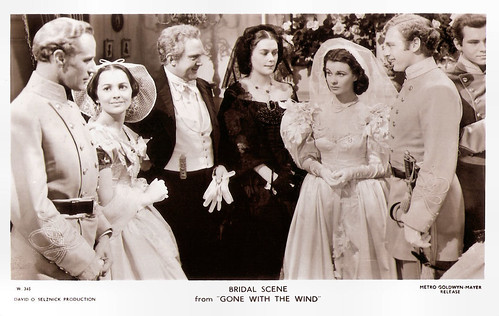
British postcard in the Picturegoer Series, London, no. W. 345. Photo: David O'Selznick Production / Metro-Goldwyn-Mayer. Leslie Howard, Olivia De Havilland and Vivien Leigh in Gone with the Wind (Victor Fleming, 1939). Caption: Bridal scene from Gone with the Wind.
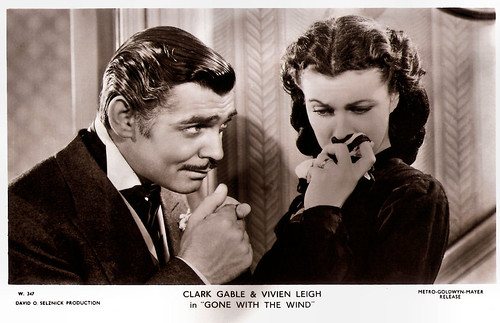
British postcard in the Picturegoer Series, London, no. W. 347. Photo: David O'Selznick Production / Metro-Goldwyn-Mayer. Vivien Leigh and Clark Gable in Gone with the Wind (Victor Fleming, 1939).

British postcard in the Picturegoer Series, London, no. W. 348. Photo: David O'Selznick Production / Metro-Goldwyn-Mayer. Leslie Howard and Olivia de Havilland in Gone with the Wind (Victor Fleming, 1939).

British postcard in the Picturegoer Series, London, no. W. 349. Photo: David O'Selznick Production / Metro-Goldwyn-Mayer. Vivien Leigh and Hattie McDaniel in Gone with the Wind (Victor Fleming, 1939).
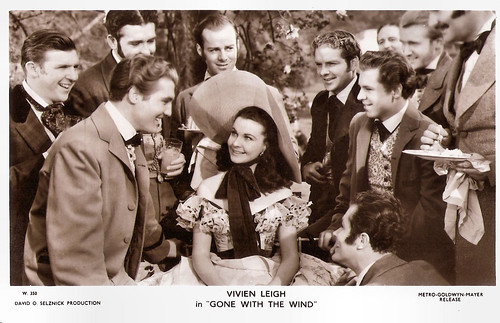
British postcard in the Picturegoer Series, London, no. W. 350. Photo: David O'Selznick Production / Metro-Goldwyn-Mayer. Vivien Leigh in Gone with the Wind (Victor Fleming, 1939).
Throughout World War II, MGM broke record breaking profits. Constance and Diana Metzinger write at their blog Silver Scenes that MGM was "dishing out colorful period films which showcased their biggest star Judy Garland (Meet Me in St. Louis, Little Nellie Kelly, The Harvey Girls); patriotic flag wavers for the women at home (Mrs. Miniver, The White Cliffs of Dover, The Clock); and chunky slices of Mayer-made American apple pie (The Andy Hardy series, The Human Comedy, Our Vines Have Tender Grapes). These films celebrated family values and were filled with scenes that made audiences weep, laugh, smile and cheer all at the same time."
Within one year, beginning in 1942, Mayer released his five highest-paid actresses from their studio contracts: Joan Crawford, Norma Shearer, Greta Garbo, Myrna Loy and Jeanette MacDonald. After a two-year hiatus, Crawford moved to Warner Brothers, where her career took a dramatic upturn. Shearer and Garbo never made another film after leaving the lot. Of the five stars, Loy and MacDonald were the only two whom Mayer rehired, in 1947 and 1948 respectively.
Increasingly, before and during World War II, Mayer came to rely on his 'College of Cardinals' — senior producers who controlled the studio's output. This management-by-committee resulted in MGM losing its momentum, developing few new stars and relying on the safety of sequels and bland material. Production values remained high. After 1940, production was cut from 50 pictures a year to a more manageable 25 features per year. During this time, MGM released very successful musicals with players such as Judy Garland, Fred Astaire, Gene Kelly, and Frank Sinatra.
Audiences began drifting to television in the late 1940s. MGM found it difficult to attract them to theatres. With its high overhead expenses, MGM's profit margins continued to decrease. Word came from Nicholas Schenck in New York: find 'a new Thalberg' who could improve quality while paring costs. Mayer thought he had found this savior in Dore Schary, a writer and producer who had found success at running RKO. Top notch musicals were Schary's focus, with hits like Easter Parade and Mario Lanza's The Great Caruso (Richard Thorpe, 1951) keeping MGM afloat.
In August 1951, Mayer was fired by MGM's East Coast executives and was replaced by Schary. Schary gradually cut loose expensive contract players including $6,000-a-week Judy Garland in 1950. He also saved money by recycling existing film sets instead of building costly new scenery, and reworking pricey old costumes. Schary managed to keep the studio running much as it had through the early 1940s though his sensibilities for hard-edged, message films would never bear much fruit.
One bright spot was MGM musical pictures, under the aegis of producer Arthur Freed, who was operating what amounted to an independent unit within the studio. MGM produced some well-regarded and profitable musicals that would be later acknowledged as classics. Among them were An American in Paris (Vincente Minnelli, 1951) with Gene Kelly, Singin' in the Rain (Stanley Donen, 1952), and Seven Brides for Seven Brothers (Stanley Donen, 1954). However, Brigadoon (Vincente Minnelli, 1954), Deep in My Heart (Stanley Donen, 1954), It's Always Fair Weather (Stanley Donen, Gene Kelly, 1955), and Invitation to the Dance (Stanley Donen, Gene Kelly, 1956), were extravagant song and dance flops, and even the now-classic The Band Wagon (Vincente Minnelli, 1953) starring Fred Astaire and Cyd Charisse, lost money in its initial release. Audiences more and more were staying home and watching television.
As the studio system faded in the late 1950s and 1960s, MGM's prestige faded with it. In 1957, the year Mayer died, the studio lost money for the first time in its 34-year history. Cost overruns and the failure of the big-budget epic Raintree County (Edward Dmytryk, 1957) starring Montgomery Clift and Elizabeth Taylor, prompted the studio to release Schary from his contract. Schary's reign at MGM had been marked with few bonafide hits, but his departure along with the retirement of Schenck in 1955, left a power vacuum that would prove difficult to fill. Initially Joseph Vogel became president and Sol Siegel head of production. By 1960, MGM had released all of its contract players, with many either retiring or moving on to television.

British postcard in the Picturegoer Series, London, no. 1281. Photo: Metro-Goldwyn-Mayer. Mickey Rooney, Ann Rutherford, Judy Garland and Lana Turner in Love Finds Andy Hardy (George B. Seitz, 1938).
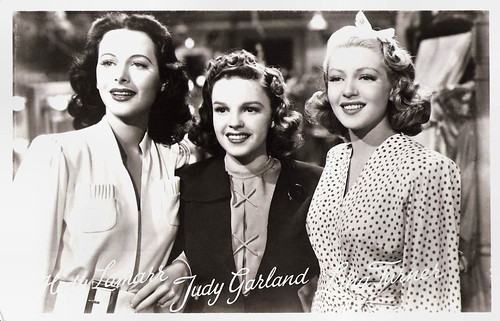
Dutch postcard, no. 3114. Photo: MGM. Hedy Lamarr, Judy Garland and Lana Turner in Ziegfeld Girl (Robert Z. Leonard, Busby Berkeley, 1941).

French postcard, no. 1. Photo: Metro-Goldwyn-Mayer. Vera Ellen and Gene Kelly in On the Town (Stanley Donen, Gene Kelly, 1949).

British postcard in the Picturegoer Series, London, no. D 40. Photo: Metro-Goldwyn-Mayer. Mario Lanza in The Great Caruso (Richard Thorpe, 1951).
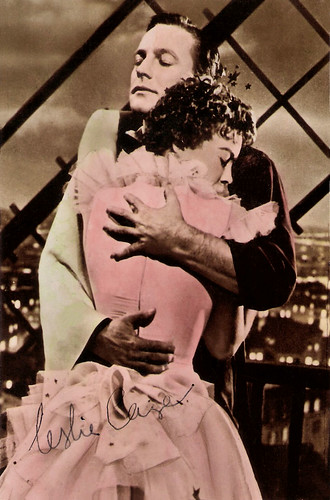
Vintage autograph card. Photo: Leslie Caron and Gene Kelly in An American in Paris (Vincente Minnelli, 1951).
In 1958, MGM released what is generally considered its last great musical, Arthur Freed's Cinemascope color production of Gigi (Vincente Minnelli, 1958), starring Leslie Caron, Maurice Chevalier, and Louis Jourdan. It was adapted from the novel by Colette, and written by the team of lyricist and librettist Alan Jay Lerner and composer Frederick Loewe, who also wrote My Fair Lady and Camelot. Gigi was a box-office and critical success which won nine Academy Awards, including Best Picture. From it came several hit songs, including 'Thank Heaven For Little Girls', 'I Remember It Well', and the Oscar-winning title song.
Gigi was the last MGM musical to win a Best Picture Oscar, an honour that had previously gone to The Broadway Melody (Harry Beaumont, 1929), The Great Ziegfeld (Robert Z. Leonard, 1936), and An American in Paris (Vincente Minnelli, 1951). The very last musical film produced by the 'Freed Unit' was an adaptation of the Broadway musical Bells Are Ringing (Vincente Minnelli, 1960) with Judy Holliday and Dean Martin. However, MGM did release later musical films, including an adaptation of Meredith Willson's The Unsinkable Molly Brown (Charles Walters, 1964) with Debbie Reynolds.
In 1959, MGM enjoyed what is quite probably its greatest financial success of later years, with the release of its nearly four-hour Technicolor epic Ben–Hur (William Wyler, 1959), a remake of its 1925 silent film hit, loosely based on the novel by General Lew Wallace. Starring Charlton Heston in the title role, the film was critically acclaimed, and won 11 Academy Awards, including Best Picture, a record that held until Titanic (James Cameron, 1997) matched it in 1997 and The Lord of the Rings: The Return of the King (Peter Jackson, 2003) in 2003.
During this period, MGM fell into a practice that would eventually sink the studio: an entire year's production schedule relied on the success of one big-budget epic each year. This policy began in 1959, when Ben–Hur was profitable enough to carry the studio through 1960. However, four succeeding big-budget epics failed: Cimarron (Anthony Mann, 1960), King of Kings (Nicholas Ray, 1961), Four Horsemen of the Apocalypse (Vincente Minnelli, 1961), and, most notoriously, Mutiny on the Bounty (Lewis Milestone, 1962), starring Marlon Brando and Trevor Howard.
The Cinerama film The Wonderful World of the Brothers Grimm (Henry Levin, George Pal, 1962) with Laurence Harvey and Karlheinz Böhm, the first film in Cinerama to actually tell a story, was also a flop. But one other epic that was a success, however, was the MGM-Cinerama co-production How the West Was Won (John Ford, Henry Hathaway, George Marshall, Richard Thorpe, 1962), with a huge all-star cast. King of Kings, while a commercial and critical flop at the time, has since come to be regarded as a film classic. The losses caused by these films led to the resignations of Sol Siegel and Joseph Vogel who were replaced by Robert M. Weitman (head of production) and Robert O'Brien (president).
The combination of O'Brien and Weitman seemed to temporarily revive the studio. MGM released David Lean's immensely popular Doctor Zhivago (David Lean, 1965), starring Omar Sharif and Julie Christie, later followed by such hits as The Dirty Dozen (Robert Aldrich, 1967) and 2001: A Space Odyssey (Stanley Kubrick, 1968). However the company's time was taken up fighting off proxy attacks by corporate raiders, and then MGM backed another series of flops, including Ryan's Daughter (David Lean, 1970). Weitman moved over to Columbia in 1967 and O'Brien was forced to resign a few years later.
Always slow to respond to the changing legal, economic, and demographic nature of the motion picture industry during the 1950s and 1960s, and although at times its films did well at the box office, the studio lost significant amounts of money throughout the 1960s. In 1966, MGM was sold to Canadian investor Edgar Bronfman Sr., whose son Edgar Jr. would later buy Universal Studios.

Dutch postcard by Sparo (Gebr. Spanjersberg N.V., Rotterdam). Photos: Metro-Goldwyn-Mayer. The pictured stars are Judy Garland, Betty Hutton, Vivian Blaine (twice), Monica Lewis, Pier Angeli, Ann Blyth and Mario Lanza, Coleen Gray, and Jane Powell. The postcard must date from ca. 1951, when Blyth and Lanza starred together in The Great Caruso (Richard Thorpe, 1951).

Dutch postcard. Photo: M.G.M. Gene Kelly and Cyd Charisse in Singin' in the Rain (Stanley Donen, Gene Kelly, 1952).

German postcard by ISV, no. B 17. Photo: Leslie Caron in Gigi (Vincente Minnelli, 1958).

French postcard by E.D.U.G., presented by Corvisart, Epinal, no. 252. Photo: Charlton Heston in Ben-Hur (William Wyler, 1959).

American postcard. Photo: MGM. Photo: Geraldine Chaplin, Omar Sharif and Julie Christie in Dr. Zhivago (David Lean, 1965).
Three years later, an increasingly unprofitable MGM was bought by Kirk Kerkorian, who slashed staff and production costs, forced the studio to produce low-budget fare, and then shut down theatrical distribution in 1973. For a time, MGM diversified into such nonfilm ventures as hotels and casinos. From 1973 on, MGM had various financial associations with another motion-picture studio, United Artists Corporation.
A portion of the backlot was sold in 1974. The last shooting done on the backlot was the introductory material for That's Entertainment! (Jack Haley Jr., 1974), a retrospective documentary that became a surprise hit for the studio. That's Entertainment! was authorised by Dan Melnick, who was appointed head of production in 1972. Under Melnick's regime, MGM made a number of successful films, including Westworld (Michael Crichton, 1973) starring Yul Brynner, Soylent Green (Richard Fleischer, 1973), The Sunshine Boys (Herbert Ross, 1975), and Network (Sidney Lumet, 1976) with Faye Dunaway, which the studio co-produced with United Artists.
However, MGM never reclaimed its former status.The studio continued to produce five to six films a year that were released through other studios, mostly United Artists. Kerkorian did, however, commit to increased production and an expanded film library when he bought United Artists in 1981. WarGames (John Badham, 1983) and the James Bond adventure Octopussy (John Glen, 1983) starring Roger Moore, were MGM/UA's only early 1980s hits, but did not push MGM into the profit range that Kerkorian wanted.
MGM ramped up internal production, as well as keeping production going at UA, which included the lucrative James Bond film franchise. It also incurred significant amounts of debt to increase production. The studio took on additional debt as a series of owners took charge in the 1980s and early 1990s. In 1986, Ted Turner bought MGM, but a few months later, sold the company back to Kirk Kerkorian to recoup massive debt, while keeping the library assets for himself. The series of deals left MGM even more heavily in debt.
MGM was bought by Pathé Communications, led by Italian publishing magnate Giancarlo Parretti, in 1990, but Parretti lost control of Pathé and defaulted on the loans used to purchase the studio. The French banking conglomerate Crédit Lyonnais, the studio's major creditor, then took control of MGM. Even more deeply in debt, MGM was purchased by a joint venture between Kerkorian, producer Frank Mancuso, and Australia's Seven Network in 1996.
The debt load from these and subsequent business deals negatively affected MGM's ability to survive as a separate motion picture studio. After a bidding war which included Time Warner and General Electric, MGM was acquired in 2004, by a partnership consisting of Sony Corporation of America, Comcast, Texas Pacific Group , Providence Equity Partners, and other investors. MGM filed for bankruptcy in 2010, but it emerged and MGM still co-produces, co-finances, and co-distributes films. Recent films include A Star Is Born (Bradley Cooper, 2018) starring Lady Gaga, and Vice (Adam McKay, 2018), and of course, we look forward to the new adventures of 007 in Bond 25 (Cary Joji Fukunaga, 2020) with Daniel Craig and Rami Malek.

Dutch card by Loeb uitgevers, Amsterdam. Photo: Danjaq S.A. Roger Moore as James Bond in Live and Let Die (Guy Hamilton, 1973). The Bond girl is the British actress Jane Seymour, who played Solitaire.

Dutch postcard by Loeb Uitgevers BV, Amsterdam. Photo: Eon Productions / Gilrose Publications / Danjaq S.A. Roger Moore in Octopussy (John Glen, 1983).
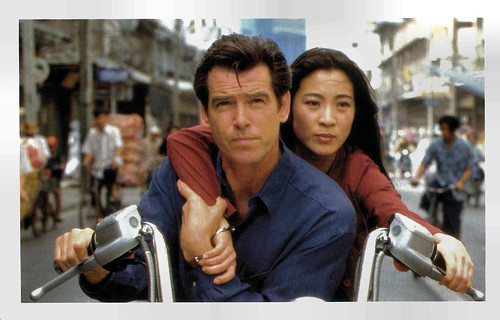
British postcard by Danjaq, LLC and United Artists Corporation. Photo: Pierce Brosnan and Michelle Yeoh in Tomorrow Never Dies (Roger Spottiswoode, 1997).

British postcard by EON Productions. Photo: Danjaq / LLC / United Artists Corporation / Columbia Pictures Ind. Daniel Craig in Casino Royale (Martin Campbell, 2006).
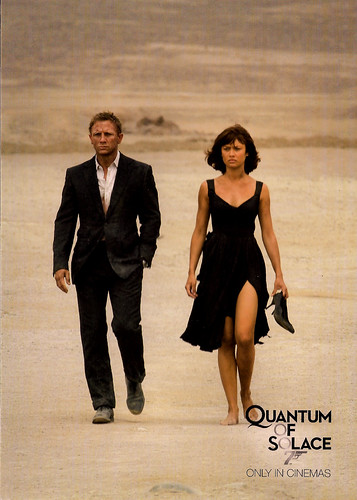
British postcard by Peek & Cloppenburg, Col., no. 198. Photo: Danjaq / LLC / United Artists Corporation / Columbia Pictures Ind. Daniel Craig and Olga Kurylenko in Quantum of Solace (Marc Forster, 2008).
Sources: Constance and Diana Metzinger (Silver Scenes), Wikipedia, Encyclopaedia Britannica and IMDb.

Jean Harlow. Spanish collectors card by J.G. Viladot, Barcelona. Photo: Metro-Goldwyn Mayer.

Judy Garland. Belgian postcard by S.A. Victoria, Brussels, no. 639. Photo: Metro-Goldwyn-Mayer.

Mickey Rooney. Belgian postcard by Victoria, Brussels, no. 639. Photo: Metro-Goldwyn-Mayer.

Katharine Hepburn. Belgian postcard by N.V. Victoria, Brussels, no. 12. Photo: Metro-Goldwyn-Mayer.

Cary Grant. Belgian postcard by N.V. Victoria, Brussels, no. 639. Photo: Metro-Goldwyn-Mayer.
A Boy Wonder and a Lion called Slats
In 1924, film theatre magnate Marcus Loew had a problem. He had bought Metro Pictures Corporation in 1919 for a steady supply of films for his large Loew's Theatres chain. With Loew's lackluster assortment of Metro films, Loew purchased Goldwyn Pictures in 1924 to improve the quality. However, these purchases created a need for someone to oversee his new Hollywood operations, since longtime assistant Nicholas Schenck was needed in New York headquarters to oversee the 150 theatres.
Approached by Louis B. Mayer, Loew addressed the situation by buying Louis B. Mayer Pictures in 1924. Mayer became head of the renamed Metro-Goldwyn-Mayer, with Irving Thalberg as head of production. Mayer would remain executive head of the studio for 25 years. The 24-year-old 'boy wonder' Thalberg became the creative head of production with the authority to reedit any MGM film, along with the no-nonsense Harry Rapf, as production supervisor. The new studio launched with tremendous success when their first silent film, He Who Gets Slapped (Victor Sjöström, 1924) starring Lon Chaney, became a critical and commercial hit.
MGM's classic logo, a roaring lion encircled in a banner with the words Ars Gratia Artis (Art for Art's Sake), was already created in 1916 for the Goldwyn Pictures Corporation by ad executive Howard Dietz. The first lion, called Slats, was used for the original Goldwyn Pictures design and for the first MGM version. He didn’t actually roar, preferring to people watch. The lion gave an audible roar on 31 July 1928 for the premiere of the film White Shadows in the South Seas. The roar was heard via a gramophone record.
From the outset, MGM tapped into the audience's need for glamour and sophistication. Having inherited few big names from their predecessor companies, Mayer and Thalberg began at once to create and publicise a host of new stars, among them were Greta Garbo, John Gilbert, William Haines, Joan Crawford, and Norma Shearer. Thalberg and Shearer soon became husband and wife.
Established names like 'the man of a thousand faces' Lon Chaney, William Powell, Buster Keaton, Marion Davies, Ramon Novarro and Wallace Beery were hired from other studios. They also hired top directors such as King Vidor, Clarence Brown, Erich von Stroheim, Tod Browning, and Victor Sjöström a.k.a. Victor Seastrom.
In its first two years, MGM produced more than 100 feature films. In 1925, MGM released the extravagant and successful Ben-Hur (Fred Niblo, 1925) featuring Ramon Novarro, taking a $4.7 million profit that year, its first full year. Soon followed two other hits, The Big Parade (King Vidor, 1925) starring John Gilbert, and Flesh and the Devil (Clarence Brown, 1926) with Gilbert and Greta Garbo. Also in 1925, MGM, Paramount and Ufa formed a joint German distributor, Parufamet.
MGM was one of the first studios to experiment with filming in Technicolor. Using the two-color Technicolor process then available, MGM filmed portions of The Uninvited Guest (Ralph Ince, 1924), The Big Parade (King Vidor, 1925), and Ben-Hur (Fred Niblo, 1925), among others, in the process. MGM released The Viking (Roy William Neill, 1928), the first complete Technicolor feature with a synchronised score and sound effects, but no spoken dialogue.
Marcus Loew died in 1927, and control of Loew's passed to Nicholas Schenck. In 1929, William Fox of Fox Film Corporation bought the Loew family's holdings with Schenck's assent. Mayer and Thalberg disagreed with the decision. Mayer was active in the California Republican Party and used his political connections to persuade the Justice Department to delay final approval of the deal on antitrust grounds.
During this time, in the summer of 1929, Fox was badly hurt in an automobile accident. By the time he recovered, the stock market crash in the fall of 1929 had nearly wiped Fox out and ended any chance of the Loew's merger going through. Schenck and Mayer had never gotten along (Mayer reportedly referred to his boss as Mr. Skunk), and the abortive Fox merger increased the animosity between the two men.

German postcard by Ross Verlag, no. 73/4. Photo: Parufamet / Metro-Goldwyn-Mayer. Ramon Novarro (or his double?) leading the chariot in Ben-Hur (Fred Niblo, 1925).

French postcard by Editions Cinémagazine, no. 393. Photo: MGM. John Gilbert in The Big Parade (King Vidor, 1925).

German postcard by Ross Verlag, no. 1886/1, 1927-1928. Photo: Clarence Sinclair Bull / Metro-Goldwyn-Mayer. Greta Garbo and John Gilbert in Flesh and the Devil (Clarence Brown, 1926).

German postcard by Ross Verlag, no. 3530/1, 1928-1929. Photo: Metro-Goldwyn Mayer. Jackie Coogan in Buttons (George W. Hill, 1927).

Lon Chaney. German postcard by Ross Verlag, no. 1894/1, 1927-1928. Photo: MGM / FaNuMet.
All-color, all-talking
MGM was the very last studio to convert to sound film with their first full-fledged 'talkie', the musical The Broadway Melody (Harry Beaumont, 1929). However, it was both a box-office success and won the Academy Award as Best Picture of the Year. MGM had moved slowly and reluctantly into the sound era, releasing features like White Shadows in the South Seas (W.S. Van Dyke, 1928) with music and sound effects, and Alias Jimmy Valentine (Jack Conway, 1928) featuring William Haines, with limited dialogue sequences. The arrival of talking pictures gave opportunities to new stars, many of whom would carry MGM through the 1930s: Clark Gable, Jean Harlow, Robert Montgomery, Spencer Tracy, Myrna Loy, Jeanette MacDonald, and Nelson Eddy among them.
MGM's first all-color, 'all-talking' sound feature with dialogue was the musical The Rogue Song (Lionel Barrymore, 1930). MGM included a sequence made in Technicolor's superior new three-color process, a musical number in the otherwise black-and-white The Cat and the Fiddle (William K. Howard, 1934), starring Jeanette MacDonald and Ramon Novarro. The studio then produced a number of three-color short subjects including the musical La Fiesta de Santa Barbara (1935). Their first complete feature in the process was Sweethearts (W.S. Van Dyke, 1938) with Jeanette MacDonald and Nelson Eddy, the earlier of the popular singing team's two films in colour. From then on, MGM regularly produced several films a year in Technicolor with Northwest Passage (King Vidor, 1940) being one of the most notable.
Grand Hotel (Edmund Goulding, 1932) became the first film to feature an 'all-star' cast for the studio with such stars as John Barrymore, Joan Crawford, Greta Garbo, Wallace Beery, and Lionel Barrymore all gathered together. Other popular films of the early 1930s included Anna Christie (Clarence Brown, 1930), The Divorcee (Robert Z. Leonard, 1930) starring Norma Shearer, Trader Horn (W.S. Van Dyke, 1931) with Harry Carey, Private Lives (Sidney Franklin, 1931), Dinner at Eight (George Cukor, 1933), and A Free Soul (Clarence Brown, 1931), starring Shearer and one of MGM's most appealing new leading men, Clark Gable.
In addition to a large short-subjects program of its own, MGM also released the shorts and features produced by Hal Roach Studios, including comedy shorts starring Laurel and Hardy, Our Gang and Charley Chase. MGM's distribution deal with Roach lasted from 1927 to 1938, and MGM benefited in particular from the success of the popular Laurel and Hardy films. In 1938, MGM purchased the rights to the Our Gang series and moved the production in-house, continuing production of the successful series of children's comedies until 1944. From 1929 to 1931, MGM produced a series of comedy shorts called All Barkie Dogville Comedies, in which trained dogs were dressed up to parody contemporary films and were voiced by actors. One of the shorts, The Dogway Melody (Zion Myers, Jules White, 1930), spoofed MGM's hit musical The Broadway Melody (1929).
MGM entered the music industry by purchasing the 'Big Three' starting with Miller Music Publishing Co. in 1934 then Robbins Music Corporation. In 1935, MGM acquired a controlling interest in the capital stock of Leo Feist, Inc., the last of the 'Big Three'. During the first musical craze of 1928-1930, a custom MGM label was created by Columbia using tunes from MGM productions that were recorded by Columbia.
MGM produced approximately 50 pictures a year, though it never met its goal of releasing a new motion picture each and every week. Loew's 153 theatres were mostly located in New York, the Northeast, and Deep South. Gone with the Wind (Victor Fleming, 1939) had its world premiere at Loew's Grand Theatre in Atlanta, Georgia. A fine reputation was gained for lavish productions that were sophisticated and polished to cater to an urban audience. Still, as the Great Depression deepened, MGM began to economise by 'recycling' existing sets, costumes, and furnishings from yesteryear projects. This recycling practice never let up once started.
In addition, MGM saved money because it was the only one of the big five studios that did not own an off-site movie ranch. Until the mid-1950s, MGM could make a claim its rivals could not: it never lost money, although it did have an occasional disaster like Parnell (John M. Stahl, 1937), Clark Gable's biggest flop. It was the only Hollywood studio that continued to pay dividends during the 1930s.

German postcard by Ross Verlag, no. 4700/1. Photo: Metro-Goldwyn-Mayer. Norma Shearer as Juliet and John Gilbert as Romeo in the early sound film The Hollywood Revue of 1929 (Charles Reisner, 1929), shot as a series of variety acts. In the film, this sequence was shot in two-color Technicolor.

German postcard by Ross Verlag, no. 7244/1, 1932-1933, distributed in Italy by Casa Editrice Ballerini & Fratini, Firenze. Photo: Metro-Goldwyn-Mayer. Jean Hersholt in Grand Hotel (Edmund Goulding, 1932).

Dutch postcard, no. 483. Photo: M.G.M. Jean Harlow and Clark Gable in Red Dust (Victor Fleming, 1932). Sent by mail in 1935.

Dutch postcard, no. 705. Photo: Metro-Goldwyn-Mayer. Charles Laughton in Mutiny on the Bounty (Frank Lloyd, 1935).

British Real Photograph postcard, London, no. FS 180. Photo: Metro-Goldwyn-Mayer. Tyrone Power and Norma Shearer in Marie Antoinette (W.S. Van Dyke, 1938).
The King of Hollywood
MGM stars dominated the box-office during the 1930s, and the studio was credited for inventing the Hollywood stable of stars system, as well. MGM contracted with the American Musical Academy of Arts Association to handle all of their press and artist development. The AMAAA's main function was to develop the budding stars and to make them appealing to the public. Stars such as Norma Shearer, Joan Crawford, Greta Garbo, Myrna Loy and Jeanette MacDonald reigned as the top-paid figures at the studio.
Another MGM sex symbol actress, Jean Harlow, who had previously appeared in the Howard Hughes film Hell's Angels (1930), now had a big break and became one of MGM's most admired stars, as well. Despite Harlow's gain, Garbo still was a big star for MGM. Shearer was still a money maker despite screen appearances becoming scarce, and Crawford continued her box-office power until 1937. MGM also received a boost through the man who would become 'King of Hollywood', Clark Gable. Gable's career took off to new heights after he won an Oscar for the Columbia film It Happened One Night (Frank Capra, 1934).
Mayer and Irving Thalberg's relationship began warmly, but eventually the two became estranged. Thalberg preferred literary works to the crowd-pleasers Mayer wanted. He enjoyed selecting novels for film adaptation. Some of these great literary films included Mutiny on the Bounty (Frank Lloyd, 1935), The Good Earth (Sidney Franklin,1936), Captains Courageous (1938), and his crowning achievement, Marie Antoinette (W.S. Van Dyke, 1938). Thalberg, always physically frail, was removed as head of production in 1932. Mayer encouraged other staff producers, among them his son-in-law David O. Selznick, but no one seemed to have the sure touch of Thalberg. As Thalberg fell increasingly ill in 1936, Louis B. Mayer could now serve as his temporary replacement. Thalberg's early death in 1936, at age 37, cost MGM dearly.
Mayer became head of production, as well as studio chief, becoming the first million-dollar executive in American history. The company remained profitable. The change toward 'series' pictures like Andy Hardy starring Mickey Rooney, Maisie starring Ann Sothern, Dr. Kildare, Tarzan, and the Thin Man starring William Powell and Myrna Loy, is evidence of Mayer's restored influence. Also playing a huge role was Ida Koverman, Mayer's secretary and right hand.
In 1937, Mayer hired Mervyn LeRoy, a former Warner Bros. producer/director as MGM's top producer and Thalberg's replacement. LeRoy talked Mayer into purchasing the rights to make a film version of the popular book The Wonderful Wizard of Oz. 1939 was undoubtedly the golden year for the studio. Hits in 1939 included The Wizard of Oz (Victor Fleming, 1939), Boys Town (Norman Taurog, 1939), The Women (George Cukor, 1938), Goodbye Mr. Chips (Sam Wood, 1939), Babes in Arms, At the Circus with The Marx Brothers, and Gone with the Wind (Victor Fleming, 1939) starring Vivien Leigh as Scarlett O'Hara and Clark Gable as Rhett Butler. It was a beautiful send-off to a glorious decade of glamour and roaring good success.

British postcard in the Picturegoer Series, London, no. W. 345. Photo: David O'Selznick Production / Metro-Goldwyn-Mayer. Leslie Howard, Olivia De Havilland and Vivien Leigh in Gone with the Wind (Victor Fleming, 1939). Caption: Bridal scene from Gone with the Wind.

British postcard in the Picturegoer Series, London, no. W. 347. Photo: David O'Selznick Production / Metro-Goldwyn-Mayer. Vivien Leigh and Clark Gable in Gone with the Wind (Victor Fleming, 1939).

British postcard in the Picturegoer Series, London, no. W. 348. Photo: David O'Selznick Production / Metro-Goldwyn-Mayer. Leslie Howard and Olivia de Havilland in Gone with the Wind (Victor Fleming, 1939).

British postcard in the Picturegoer Series, London, no. W. 349. Photo: David O'Selznick Production / Metro-Goldwyn-Mayer. Vivien Leigh and Hattie McDaniel in Gone with the Wind (Victor Fleming, 1939).

British postcard in the Picturegoer Series, London, no. W. 350. Photo: David O'Selznick Production / Metro-Goldwyn-Mayer. Vivien Leigh in Gone with the Wind (Victor Fleming, 1939).
Dishing out chunky slices of Mayer-made American apple pie
Throughout World War II, MGM broke record breaking profits. Constance and Diana Metzinger write at their blog Silver Scenes that MGM was "dishing out colorful period films which showcased their biggest star Judy Garland (Meet Me in St. Louis, Little Nellie Kelly, The Harvey Girls); patriotic flag wavers for the women at home (Mrs. Miniver, The White Cliffs of Dover, The Clock); and chunky slices of Mayer-made American apple pie (The Andy Hardy series, The Human Comedy, Our Vines Have Tender Grapes). These films celebrated family values and were filled with scenes that made audiences weep, laugh, smile and cheer all at the same time."
Within one year, beginning in 1942, Mayer released his five highest-paid actresses from their studio contracts: Joan Crawford, Norma Shearer, Greta Garbo, Myrna Loy and Jeanette MacDonald. After a two-year hiatus, Crawford moved to Warner Brothers, where her career took a dramatic upturn. Shearer and Garbo never made another film after leaving the lot. Of the five stars, Loy and MacDonald were the only two whom Mayer rehired, in 1947 and 1948 respectively.
Increasingly, before and during World War II, Mayer came to rely on his 'College of Cardinals' — senior producers who controlled the studio's output. This management-by-committee resulted in MGM losing its momentum, developing few new stars and relying on the safety of sequels and bland material. Production values remained high. After 1940, production was cut from 50 pictures a year to a more manageable 25 features per year. During this time, MGM released very successful musicals with players such as Judy Garland, Fred Astaire, Gene Kelly, and Frank Sinatra.
Audiences began drifting to television in the late 1940s. MGM found it difficult to attract them to theatres. With its high overhead expenses, MGM's profit margins continued to decrease. Word came from Nicholas Schenck in New York: find 'a new Thalberg' who could improve quality while paring costs. Mayer thought he had found this savior in Dore Schary, a writer and producer who had found success at running RKO. Top notch musicals were Schary's focus, with hits like Easter Parade and Mario Lanza's The Great Caruso (Richard Thorpe, 1951) keeping MGM afloat.
In August 1951, Mayer was fired by MGM's East Coast executives and was replaced by Schary. Schary gradually cut loose expensive contract players including $6,000-a-week Judy Garland in 1950. He also saved money by recycling existing film sets instead of building costly new scenery, and reworking pricey old costumes. Schary managed to keep the studio running much as it had through the early 1940s though his sensibilities for hard-edged, message films would never bear much fruit.
One bright spot was MGM musical pictures, under the aegis of producer Arthur Freed, who was operating what amounted to an independent unit within the studio. MGM produced some well-regarded and profitable musicals that would be later acknowledged as classics. Among them were An American in Paris (Vincente Minnelli, 1951) with Gene Kelly, Singin' in the Rain (Stanley Donen, 1952), and Seven Brides for Seven Brothers (Stanley Donen, 1954). However, Brigadoon (Vincente Minnelli, 1954), Deep in My Heart (Stanley Donen, 1954), It's Always Fair Weather (Stanley Donen, Gene Kelly, 1955), and Invitation to the Dance (Stanley Donen, Gene Kelly, 1956), were extravagant song and dance flops, and even the now-classic The Band Wagon (Vincente Minnelli, 1953) starring Fred Astaire and Cyd Charisse, lost money in its initial release. Audiences more and more were staying home and watching television.
As the studio system faded in the late 1950s and 1960s, MGM's prestige faded with it. In 1957, the year Mayer died, the studio lost money for the first time in its 34-year history. Cost overruns and the failure of the big-budget epic Raintree County (Edward Dmytryk, 1957) starring Montgomery Clift and Elizabeth Taylor, prompted the studio to release Schary from his contract. Schary's reign at MGM had been marked with few bonafide hits, but his departure along with the retirement of Schenck in 1955, left a power vacuum that would prove difficult to fill. Initially Joseph Vogel became president and Sol Siegel head of production. By 1960, MGM had released all of its contract players, with many either retiring or moving on to television.

British postcard in the Picturegoer Series, London, no. 1281. Photo: Metro-Goldwyn-Mayer. Mickey Rooney, Ann Rutherford, Judy Garland and Lana Turner in Love Finds Andy Hardy (George B. Seitz, 1938).

Dutch postcard, no. 3114. Photo: MGM. Hedy Lamarr, Judy Garland and Lana Turner in Ziegfeld Girl (Robert Z. Leonard, Busby Berkeley, 1941).

French postcard, no. 1. Photo: Metro-Goldwyn-Mayer. Vera Ellen and Gene Kelly in On the Town (Stanley Donen, Gene Kelly, 1949).

British postcard in the Picturegoer Series, London, no. D 40. Photo: Metro-Goldwyn-Mayer. Mario Lanza in The Great Caruso (Richard Thorpe, 1951).

Vintage autograph card. Photo: Leslie Caron and Gene Kelly in An American in Paris (Vincente Minnelli, 1951).
A nearly four-hour Technicolor epic
In 1958, MGM released what is generally considered its last great musical, Arthur Freed's Cinemascope color production of Gigi (Vincente Minnelli, 1958), starring Leslie Caron, Maurice Chevalier, and Louis Jourdan. It was adapted from the novel by Colette, and written by the team of lyricist and librettist Alan Jay Lerner and composer Frederick Loewe, who also wrote My Fair Lady and Camelot. Gigi was a box-office and critical success which won nine Academy Awards, including Best Picture. From it came several hit songs, including 'Thank Heaven For Little Girls', 'I Remember It Well', and the Oscar-winning title song.
Gigi was the last MGM musical to win a Best Picture Oscar, an honour that had previously gone to The Broadway Melody (Harry Beaumont, 1929), The Great Ziegfeld (Robert Z. Leonard, 1936), and An American in Paris (Vincente Minnelli, 1951). The very last musical film produced by the 'Freed Unit' was an adaptation of the Broadway musical Bells Are Ringing (Vincente Minnelli, 1960) with Judy Holliday and Dean Martin. However, MGM did release later musical films, including an adaptation of Meredith Willson's The Unsinkable Molly Brown (Charles Walters, 1964) with Debbie Reynolds.
In 1959, MGM enjoyed what is quite probably its greatest financial success of later years, with the release of its nearly four-hour Technicolor epic Ben–Hur (William Wyler, 1959), a remake of its 1925 silent film hit, loosely based on the novel by General Lew Wallace. Starring Charlton Heston in the title role, the film was critically acclaimed, and won 11 Academy Awards, including Best Picture, a record that held until Titanic (James Cameron, 1997) matched it in 1997 and The Lord of the Rings: The Return of the King (Peter Jackson, 2003) in 2003.
During this period, MGM fell into a practice that would eventually sink the studio: an entire year's production schedule relied on the success of one big-budget epic each year. This policy began in 1959, when Ben–Hur was profitable enough to carry the studio through 1960. However, four succeeding big-budget epics failed: Cimarron (Anthony Mann, 1960), King of Kings (Nicholas Ray, 1961), Four Horsemen of the Apocalypse (Vincente Minnelli, 1961), and, most notoriously, Mutiny on the Bounty (Lewis Milestone, 1962), starring Marlon Brando and Trevor Howard.
The Cinerama film The Wonderful World of the Brothers Grimm (Henry Levin, George Pal, 1962) with Laurence Harvey and Karlheinz Böhm, the first film in Cinerama to actually tell a story, was also a flop. But one other epic that was a success, however, was the MGM-Cinerama co-production How the West Was Won (John Ford, Henry Hathaway, George Marshall, Richard Thorpe, 1962), with a huge all-star cast. King of Kings, while a commercial and critical flop at the time, has since come to be regarded as a film classic. The losses caused by these films led to the resignations of Sol Siegel and Joseph Vogel who were replaced by Robert M. Weitman (head of production) and Robert O'Brien (president).
The combination of O'Brien and Weitman seemed to temporarily revive the studio. MGM released David Lean's immensely popular Doctor Zhivago (David Lean, 1965), starring Omar Sharif and Julie Christie, later followed by such hits as The Dirty Dozen (Robert Aldrich, 1967) and 2001: A Space Odyssey (Stanley Kubrick, 1968). However the company's time was taken up fighting off proxy attacks by corporate raiders, and then MGM backed another series of flops, including Ryan's Daughter (David Lean, 1970). Weitman moved over to Columbia in 1967 and O'Brien was forced to resign a few years later.
Always slow to respond to the changing legal, economic, and demographic nature of the motion picture industry during the 1950s and 1960s, and although at times its films did well at the box office, the studio lost significant amounts of money throughout the 1960s. In 1966, MGM was sold to Canadian investor Edgar Bronfman Sr., whose son Edgar Jr. would later buy Universal Studios.

Dutch postcard by Sparo (Gebr. Spanjersberg N.V., Rotterdam). Photos: Metro-Goldwyn-Mayer. The pictured stars are Judy Garland, Betty Hutton, Vivian Blaine (twice), Monica Lewis, Pier Angeli, Ann Blyth and Mario Lanza, Coleen Gray, and Jane Powell. The postcard must date from ca. 1951, when Blyth and Lanza starred together in The Great Caruso (Richard Thorpe, 1951).

Dutch postcard. Photo: M.G.M. Gene Kelly and Cyd Charisse in Singin' in the Rain (Stanley Donen, Gene Kelly, 1952).

German postcard by ISV, no. B 17. Photo: Leslie Caron in Gigi (Vincente Minnelli, 1958).

French postcard by E.D.U.G., presented by Corvisart, Epinal, no. 252. Photo: Charlton Heston in Ben-Hur (William Wyler, 1959).

American postcard. Photo: MGM. Photo: Geraldine Chaplin, Omar Sharif and Julie Christie in Dr. Zhivago (David Lean, 1965).
Bidding wars and massive debts
Three years later, an increasingly unprofitable MGM was bought by Kirk Kerkorian, who slashed staff and production costs, forced the studio to produce low-budget fare, and then shut down theatrical distribution in 1973. For a time, MGM diversified into such nonfilm ventures as hotels and casinos. From 1973 on, MGM had various financial associations with another motion-picture studio, United Artists Corporation.
A portion of the backlot was sold in 1974. The last shooting done on the backlot was the introductory material for That's Entertainment! (Jack Haley Jr., 1974), a retrospective documentary that became a surprise hit for the studio. That's Entertainment! was authorised by Dan Melnick, who was appointed head of production in 1972. Under Melnick's regime, MGM made a number of successful films, including Westworld (Michael Crichton, 1973) starring Yul Brynner, Soylent Green (Richard Fleischer, 1973), The Sunshine Boys (Herbert Ross, 1975), and Network (Sidney Lumet, 1976) with Faye Dunaway, which the studio co-produced with United Artists.
However, MGM never reclaimed its former status.The studio continued to produce five to six films a year that were released through other studios, mostly United Artists. Kerkorian did, however, commit to increased production and an expanded film library when he bought United Artists in 1981. WarGames (John Badham, 1983) and the James Bond adventure Octopussy (John Glen, 1983) starring Roger Moore, were MGM/UA's only early 1980s hits, but did not push MGM into the profit range that Kerkorian wanted.
MGM ramped up internal production, as well as keeping production going at UA, which included the lucrative James Bond film franchise. It also incurred significant amounts of debt to increase production. The studio took on additional debt as a series of owners took charge in the 1980s and early 1990s. In 1986, Ted Turner bought MGM, but a few months later, sold the company back to Kirk Kerkorian to recoup massive debt, while keeping the library assets for himself. The series of deals left MGM even more heavily in debt.
MGM was bought by Pathé Communications, led by Italian publishing magnate Giancarlo Parretti, in 1990, but Parretti lost control of Pathé and defaulted on the loans used to purchase the studio. The French banking conglomerate Crédit Lyonnais, the studio's major creditor, then took control of MGM. Even more deeply in debt, MGM was purchased by a joint venture between Kerkorian, producer Frank Mancuso, and Australia's Seven Network in 1996.
The debt load from these and subsequent business deals negatively affected MGM's ability to survive as a separate motion picture studio. After a bidding war which included Time Warner and General Electric, MGM was acquired in 2004, by a partnership consisting of Sony Corporation of America, Comcast, Texas Pacific Group , Providence Equity Partners, and other investors. MGM filed for bankruptcy in 2010, but it emerged and MGM still co-produces, co-finances, and co-distributes films. Recent films include A Star Is Born (Bradley Cooper, 2018) starring Lady Gaga, and Vice (Adam McKay, 2018), and of course, we look forward to the new adventures of 007 in Bond 25 (Cary Joji Fukunaga, 2020) with Daniel Craig and Rami Malek.

Dutch card by Loeb uitgevers, Amsterdam. Photo: Danjaq S.A. Roger Moore as James Bond in Live and Let Die (Guy Hamilton, 1973). The Bond girl is the British actress Jane Seymour, who played Solitaire.

Dutch postcard by Loeb Uitgevers BV, Amsterdam. Photo: Eon Productions / Gilrose Publications / Danjaq S.A. Roger Moore in Octopussy (John Glen, 1983).

British postcard by Danjaq, LLC and United Artists Corporation. Photo: Pierce Brosnan and Michelle Yeoh in Tomorrow Never Dies (Roger Spottiswoode, 1997).

British postcard by EON Productions. Photo: Danjaq / LLC / United Artists Corporation / Columbia Pictures Ind. Daniel Craig in Casino Royale (Martin Campbell, 2006).

British postcard by Peek & Cloppenburg, Col., no. 198. Photo: Danjaq / LLC / United Artists Corporation / Columbia Pictures Ind. Daniel Craig and Olga Kurylenko in Quantum of Solace (Marc Forster, 2008).
Sources: Constance and Diana Metzinger (Silver Scenes), Wikipedia, Encyclopaedia Britannica and IMDb.
No comments:
Post a Comment